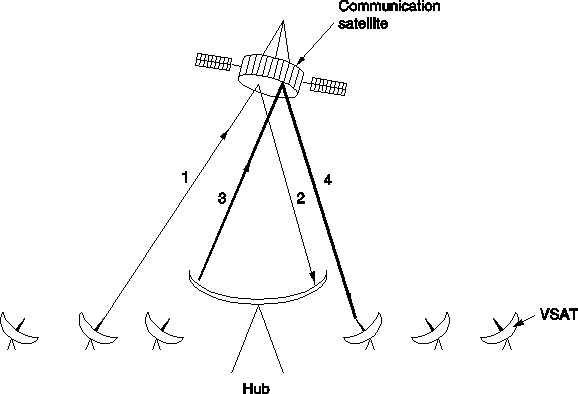|
|
|
|
In the 1950s and early 1960s people tried to set up communication systems by bouncing signals off metalized balloons. Unfortunately, the received signals were too week to be of any practical use. The US Navy built an operational system for ship-to-shore communication by bouncing signal off the moon.
Further progress in the celestial communication came with the first communication satellite launched in 1962. The artificial satellites can amplify the signal before sending them back and can be thought as a big microwave repeaters in the sky.
Communication satellites contain several transpoders, each of which listens
to some portion of the spectrum, amplifies the incoming signal, and then
rebroadcasts it at another frequency, to avoid interference with the
incoming signal. The downward beams can be broad, covering a substantial
fraction of the earth's surface, or narrow, covering an area only hundreds
of kilometers in diameter.
2.8.1. Geosynchronous Satellites
According to Kepler's law, the orbital period of a satellite varies as the orbital radius to the 3/2 power. Near the surface of the earth, the period is about 90 minutes that use useless for communication satellites. However, at an altitude approximately 36000 km above the equator, the satellite period is 24 hours, so it revolves at the same rate as the earth under it. It is very desirable for communication purposes.
With current technology, it is in general unwise to have satellites spaced much closer than 2 degrees in the 360 degree equatorial plane, to avoid interference. So we have just 180 slots for geosynchronous satellites. Fortunately, satellites using different parts of spectrum do not compete, so each of the 180 possible satellites could have several data streams going up and down simultaneously. Alternatively, two or more satellites could occupy one orbit slot if they operate at different frequencies.
There have been international agreement about who may use which orbit slots and frequencies. The main commercial bands are the following (Fig. 2-55):

Fig. 2-55. The principal satellite bands.
In addition to these commercial bands, many government and military bands also exist.
A typical satellite has 12-20 transpoders, each with 36-50 MHz bandwidth (e.g., a 50 Mbps transpoder can handle 800 64 kbps digital voice channels).
The first satellites had a single spatial beam that illuminated the entire earth. Nowadays, each downward beam can be focused on a small geographical area, typically elliptically shaped, and as small as a few hundreds km in diameter (so called spot beams).
A new development in the communication satellite world is the development of low-cost microstations, sometimes called VSATs (Very Small Aperture Terminals). These tiny terminals can put out only small power (1 watt) and the communication among them is ensured by using a special ground station, the hub, with a large antenna and amplifier (Fig. 2-56). The trade off is a longer delay.

Fig. 2-56. VSATs using a hub.
Differences between communication satellites communication and terrestrial microwave links communication:
For the first 30 years of satellite era, low-orbit satellites were rarely used for communication because they zip into and out of view so quickly. In 1990, Motorola started a new activity called Iridium project, aimed to communication based on low orbit satellites.
The basic goal of Iridium is to provide worldwide telecommunication service using hand-held devices that communicate directly with Iridium satellites. This service competes with PCS/PCN activities.
The project uses ideas from cellular radio, but with moving cells. The satellites beams scan the earth as the satellites move. The handover techniques used in cellular radio are applicable also in this case.
The satellites (66 in total) are to be positioned at an altitude of 750 km, in circular polar orbits (Fig 2-57(a)). With 6 satellite necklaces, the entire earth would be covered (Fig. 2-57(b)).

Fig. 2-57. (a) The Iridium satellites from six necklaces around
the earth. (b) 1628 moving cells cover the earth.
A comparison between satellite communication and terrestrial communication is instructive.
20 years ago, it could seem that the future of communication is in communication satellites. Telephone system had changed little in the past 100 years and showed no signs of changing in the next 10 years. This glacial movement was caused in no small part by the regulatory environment in which telephone companies were expected to provide good voice services at reasonable prices (which they did), and in return got a guaranteed profit on their investments. For people with data to transmit, 1200 bps modems were available. That was pretty much all there was.
The introduction of competition in 1984 in the US and somewhat later in Europe change all that radically. Telephone companies began replacing their long-haul networks with fiber and introduced high bandwidth services. They also stopped of charging artificially high prices to long-distance users to subsidize local service. In this situation, terrestrial fiber connections looked like the long-term winner.
Nevertheless, communication satellites have some major niche market that fiber does not address. They are:
In short, it looks like the mainstream communication of the future will be terrestrial fiber optics combined with cellular radio, but for some specialized uses, satellites are better. However, economics can influence all of this. Terrestrial and satellite communication will compete on price. If advances of technology radically reduce the cost of deploying a satellite, or low-orbit satellites catch on, it is not certain that fiber will win in all markets.